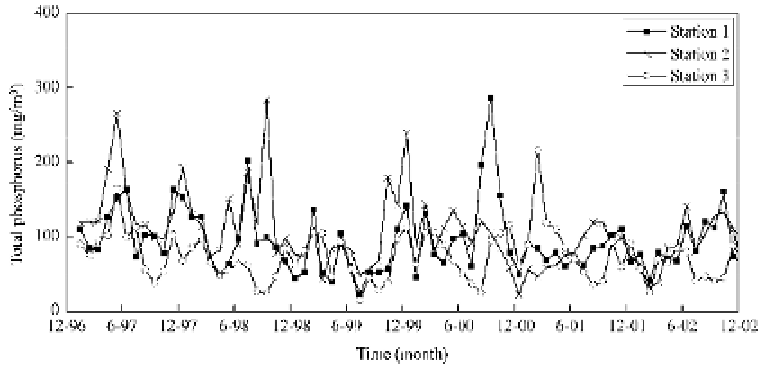Environmental Engineering Reference
In-Depth Information
Fig. 8.39
Observed TP concentration at three sampling stations in Taihu Lake during 1997-2002
According to observation data, from 2000 to 2005, the averaged TP is up to 78 mg/m
3
. Except for east
and south parts, nearly 87% of the entire Taihu Lake was suffering from nutrients aggregation. As shown
in Fig. 8.39, compared to the 1960s the concentrations of TP at these three stations have increased by 10-30
times due to high nutrient input from domestic sources and agricultural activities. For this reason, an algal
bloom might break out without warning if the weather and physical conditions are favorable for algal
growth. For example, in the early summer of 2007, a massive and wide spread bloom of cyanobacteria
broke out in Taihu Lake, stimulated by extremely high concentrations of nutrients and unusually hot dry
weather. This bloom covered about one-third of the lake and severely destroyed the water supply system
(Fig. 8.40), and local residents of Wuxi, a city of 5 million, had to resort to bottled drinking water for
several days. According to the Administration Bureau of Taihu Lake Basin, during the bloom, the chlorophyll
concentrations at the water-supply sources of the north part of the lake all reached very high levels
(Xiaowanli Waterworks, 259 ȝg/L; Gonghu Waterworks, 139 ȝg/L; and Xidong Waterworks, 53 ȝg/L).
Consequentially, their DO concentrations declined to a very low level, almost to zero.
Fig. 8.40
A bloom of cyanobacteria at a water intake area of Wuxi, June, 2007 (Xinhua News Agency,
http://www.xinhuanet.com) (See color figure at the end of this topic)



Search WWH ::

Custom Search